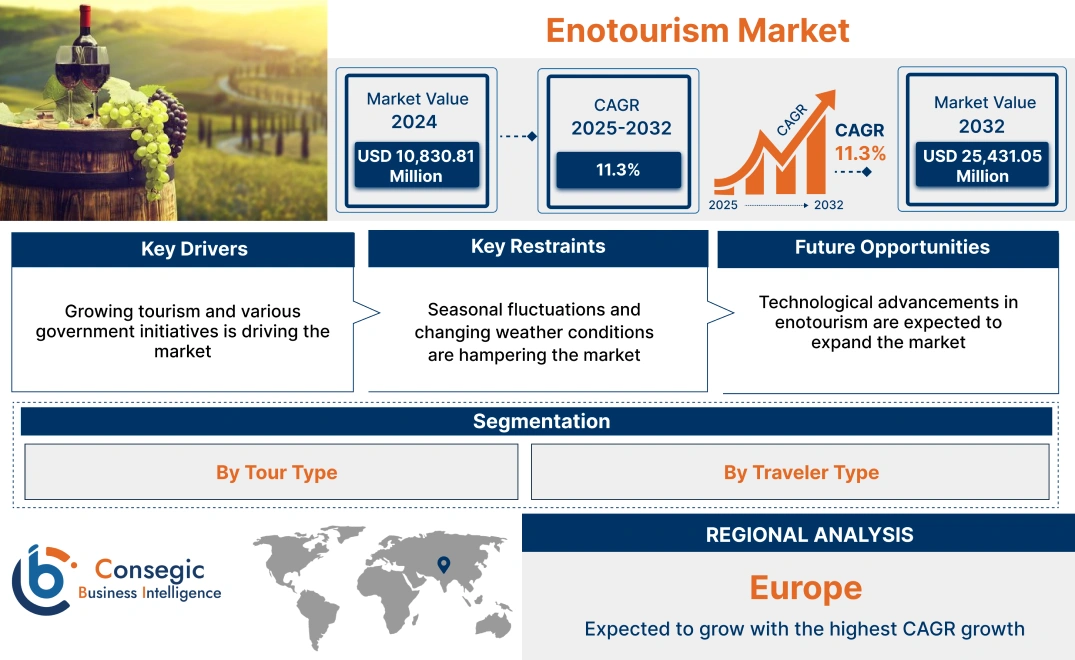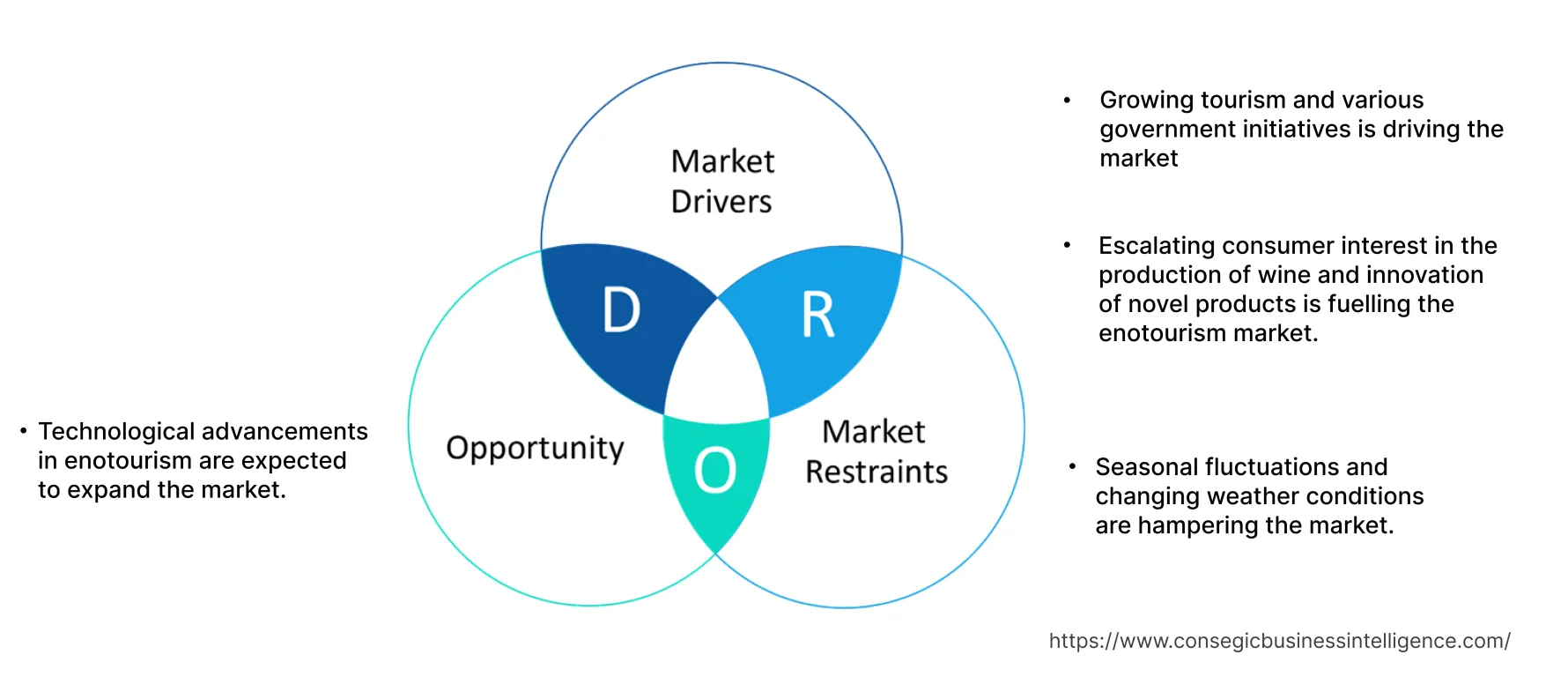- Summary
- Table Of Content
- Methodology
Enotourism Market Size :
Enotourism Market size is estimated to reach over USD 25,431.05 Million by 2032 from a value of USD 10,830.81 Million in 2024 and is projected to grow by USD 11,857.37 Million in 2025, growing at a CAGR of 11.30 % from 2025 to 2032.
Enotourism Market Definition & Overview :
Enotourism which is also wine tourism is travel and discovery of wine producing areas, vineyards, and wineries. This specialized type of travel places which focuses on an extensive trip which includes wine tasting, guided vineyard tours, and extensive understanding of the wine-making process. Cultural elements and ecotourism frequently co-exist, allowing guests to enjoy the history, customs, and cuisine associated with a specific region's wine production. Tourism is gaining popularity as it is an innovative way for individuals to travel and taste different types of wines in wine-growing environments.
The tourism reaches out to wine enthusiasts looking for an immersive experience in wineries and vineyards, encouraging a closer relationship with the world of wine. Along with wine tasting, it includes cultural enrichment through culinary pairing, wine events, and guided tours. Local economies gain greatly from wine tourism, which further helps the demand and trends of artisans, wineries, and the tourism sector.
Enotourism Market Insights :
Key Drivers :
Growing tourism and various government initiatives is driving the market
Growing tourism and a number of government initiatives are driving significant momentum in the enotourism market. The rise in worldwide tourism, driven by a growing desire for unique and specialized travel experiences, is encouraging wine tourism. Discovering vineyards and wineries offers a distinctive fusion of culture and gastronomy, and is a perfect fit with the trend of travelers seeking authentic and unforgettable experiences. Governments all over are introducing policies to support and grow the wine tourism sector because of its potential for economic trends. The government seeks and promotes their regions as tourist attractions, and desirable wine destinations, to support local economies, and create job opportunities through the implementation of financial incentives, infrastructure development, and strategic policies.
Furthermore, government support encompasses a regulatory framework that promotes the expansion of this tourism, such as accelerating winery licensing procedures and the establishment of infrastructure beneficial to tourism in wine regions. The general accessibility and appeal of this tourism are enhanced by these initiatives. As per the analysis, to increase the awareness and appeal of wine-producing regions, these initiatives frequently entail the creation of wine marketing, events, and campaigns. For instance, in May 2022, The Greek National Tourism Organization partnered with fine dining Mayfair restaurant to launch a campaign called The Wine Trails of Greece. This initiative was introduced to promote wine tourism in Greece. Thus, the rise in tourism and various government initiatives are boosting the demand and enotourism market trends.
Escalating consumer interest in the production of wine and innovation of novel products is fuelling the enotourism market.
Growing consumer interest in wine production indicates a significant change in how people view and savor this beverage. Customers are actively looking for ways to learn about how wine is made, by going to tasting workshops, and vineyard tours. Based on the analysis, these interactions help to connect people with the rich history of winemaking while also clarifying the complicated process of grape planting, fermentation, and aging.
This type of tourism helps in the direct interaction of individuals and winemaking professionals. Wine enthusiasts are drawn towards the scenic environment of vineyards and wineries, where they are able to observe the procedures that go into creating a bottle of wine. This extensive experience enhances individuals understanding of winemaking. Moreover, based on the analysis, wineries constantly add new wine varieties to their arrangements and introduce novel wine products. These new offerings are meant to give wine lovers new and interesting options, making the whole experience better for customers. For instance, in June 2023, Balfour Winery launched a novel and innovative range of still wines. The range of these wines showcases state-of-art winery inspiration for their wine products. Thus, the rise in consumer interest in wines and their production is boosting the enotourism market demand.
Key Restraints :
Seasonal fluctuations and changing weather conditions are hampering the market.
Most of the tourist places, wineries, and vineyards are affected because of seasonal fluctuations and changing weather conditions. Seasonal variations are an important aspect to be considered because wine tourism is most popular during a certain period, which is frequently connected to harvest seasons or ideal weather. However, the off seasons generally cause a decrease in visitors number, which causes an uneven income, and possible job difficulties in this sector. As per the analysis, due to its inherent connection to outdoor activities such as wine tours and tasting, it is vulnerable to bad weather. Unpredictable weather patterns such as heavy rains, and burning temperatures may cause disruptions to scheduled events lowering the quality of the visitor's experience overall. Such weather-related uncertainties have the potential to discourage potential travelers and lower the industry's attraction.
High-seasonality destinations frequently face a range of issues, such as overcrowding, excessive expenses, poor infrastructure during peak seasons, and lack of services and employment opportunities during off-seasons. Thus, the seasonal variations and changing weather conditions are restraining the demand and trends of the market.
Future Opportunities :
Technological advancements in enotourism are expected to expand the market.
The tourism sector has been transformed by technological advancements, enhancing the visitor experience through enotourism. Incorporating augmented reality (AR) into wine tours is an interesting development. Guests with AR-capable devices, now immerse themselves in interactive stories that showcase the unique characteristics of each vineyard and offer historical insights. The use of artificial intelligence (AI) in wine tourism is crucial, as it provides tailored suggestions. AI algorithms evaluate customer preferences and recommend wines based on individual tastes, improving the overall tasting experience. AI-based chatbots and virtual assistants offers current details about winery tours, events, lodging, and various attractions.
Smart sensors installed in vineyards collect information on weather patterns, soil conditions, and the grape's development. These sensors allow vineyard supervisors to make accurate decisions to maximize the grape quality. By ensuring sustainable and effective vineyard management, these agricultural techniques help produce superior quality vines.
Virtual tasting has grown in popularity, particularly after travel restrictions due to global events. Wineries now provide virtual tours that allow individuals to take part in guided wine tastings from the comfort of their homes. This helps wineries to reach a wider audience. Many wineries have introduced virtual tours, tasting events, and packages to attract and engage audiences in the wine industry. For instance, in June 2023, Kenefick Ranch which is a family-owned winery introduced its new Virtual Tasting Experience Packages. These packages are created in a way where wine lovers are able to experience wine tasting at their homes. Thus, these advancements are creating lucrative enotourism market opportunities and trends.
Enotourism Market Report Insights :
| Report Attributes | Report Details |
| Study Timeline | 2019-2032 |
| Market Size in 2032 | USD 25,431.05 Million |
| CAGR (2025-2032) | 11.3% |
| By Tour Type | Private-guided tours, and Self-guided tour |
| By Traveler Type | Solo, and Group |
| By Region | North America, Europe, Asia Pacific, Latin America, and Middle East & Africa |
| Key Players | Iowa wine tour, Fredericksburg Wine Tours, California Wine Tours and Transportation, Baja California Wine Tours, elcielovalledeguadalupe, Sula Vineyards, Grapevine Wine Tours, LLC, A Great Oregon Wine Tour, Wine On 29, LLC, Lewis Clark Valley, Grape Escapes, WINEDERING, The Grand Wine Tour, Winetourism |
| Geographies Covered | |
| North America | U.S. Canada Mexico |
| Europe | U.K. Germany France Spain Italy Russia Benelux Rest of Europe |
| APAC | China South Korea Japan India Australia ASEAN Rest of Asia-Pacific |
| Middle East and Africa | GCC Turkey South Africa Rest of MEA |
| LATAM | Brazil Argentina Chile Rest of LATAM |
| Report Coverage | Revenue Forecast, Competitive Landscape, Growth Factors, Restraint or Challenges, Opportunities, Environment & Regulatory Landscape, PESTLE Analysis, PORTER Analysis, Key Technology Landscape, Value Chain Analysis, Cost Analysis, and Regional Trends & Forecast |
Enotourism Market Segmental Analysis :
Based on the Tour Type :
The Tour Type is categorized into private-guided tours and self-guided tours. In 2024, the private guided tour segment accounted for the highest enotourism market share of 53.03% in the market. Private guided tours provide individualized insights and an itinerary that is customized to your preference. They are knowledgeable about the minute details of local wine culture. These guides help to understand and appreciate the wines by imparting extensive knowledge about the wine-making procedures, specific characteristics of each vineyard, and the local geography. Private-guided tours are unique because of their status and flexibility. Whether it's concentrating on particular grape varieties, visiting wineries off the track, or setting up a private tasting with well-known winemakers, guides can customize the tour that suit the interest. This more personal approach enables a closer relationship with the wine and the area. For instance, in January 2024, Happy Cork launches its New Tasting Room for In-Store Wine & Spirits Tastings and Private Events. Thus the above factors are boosting the trend of the segment.
Furthermore, the self-guided tour segment is expected to hold the highest CAGR over the forecast period in the enotourism market. A self-guided tour is an autonomous, customized tour of wine regions that allows visitors to create and follow their own schedule. Individuals are able to design a flexible schedule that accounts for the chosen winery operating hours and travel distances. People participate in activities such as wine tasting, and vineyard tours. A self-guided tourism experience gives the visitor the freedom to customize their trip, creating a singular and individualized look in wine preparation. As per the analysis, Many wine-tasting events are launched for people to experience different wines. Individuals with self-guided tours can participate in such events. Thus, these factors are boosting the trend of the segment.
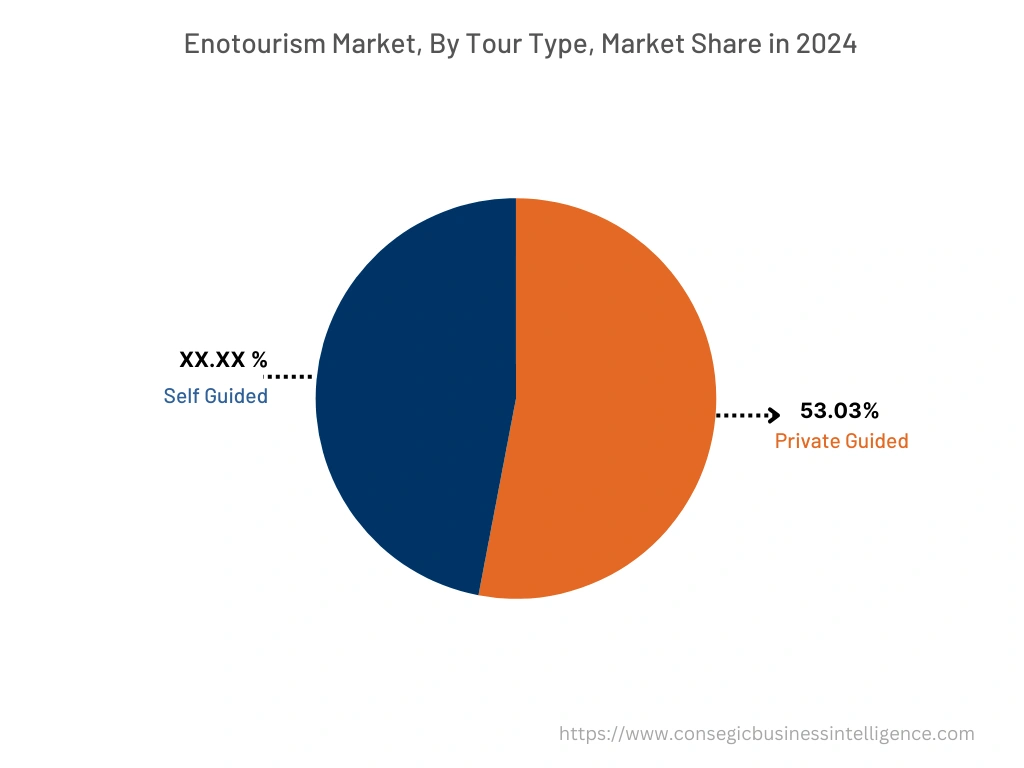
Based on the Traveler Type :
The Traveler type segment is categorized into solo and group. In 2024, the group segment accounted for the highest market share in the overall enotourism market. The enotourism industry is greatly influenced by group travel. Tours, tasting, and culinary adventures in vineyards create memories and opportunities for social interaction among participants. The ability to split costs for lodging, transportation, and group activities among individuals is one of the main benefits of group travel, which increases the economic viability of this tourism. Destinations that promote enotourism frequently provide groups with specialized tours, exclusive events, and private tasting in addition to specifically designed itineraries that aim to improve the overall experience. The vineyard setting is a perfect fit for celebrations and events, drawing groups for corporate get-togethers, anniversaries, and birthdays. Many companies offer group traveling packages for customers with event planning and tours over the globe. For instance, STIC Travel Group announces a joint venture with Take-A-Break (TAB) Consulting. It aims to offer a range of services including complete travel logistics and event planning and execution for various group travelling activities. Thus, the group traveling is boosting the growth of the segment.
Moreover, the solo segment is expected to grow at the fastest CAGR over the forecast period in the enotourism market. Solo travelers are travelers on their own. Most people prefer solo traveling because of the flexibility, independence, and customized experience that it provides. Solo travelers are able to explore wine regions at their own pace and select wineries based on their preferences, and are able to create their own itineraries. The rise in solo travelers is influencing the travel market. For instance, according to the India Brand Equity Foundation, in October 2023, estimated the travel market to reach USD 125 billion. Thus, these factors are boosting the growth and trends of the segment.
Based on the Region :
The regional segment includes North America, Europe, Asia Pacific, the Middle East and Africa, and Latin America.
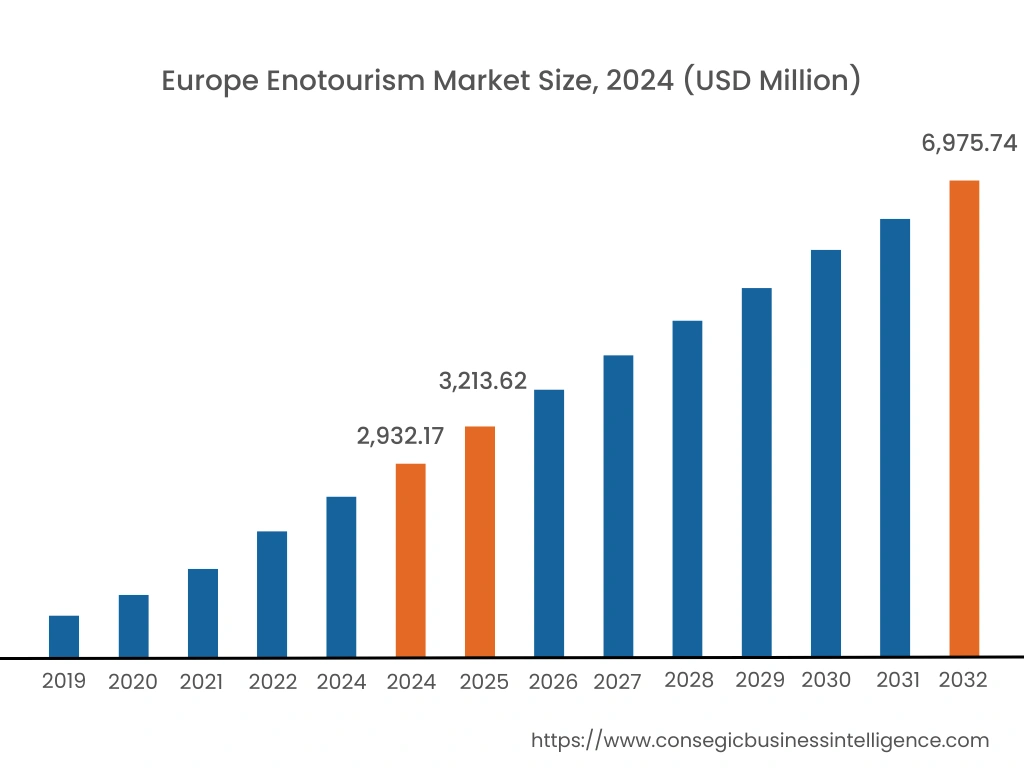
In 2024, Europe accounted for the highest market share at 34.96% valued at USD 2,932.17 Million, it is expected to reach USD 6,975.74 Million in 2032. Germany accounted for the highest market share of 23.05% in Europe region. As per the enotourism market analysis, European nations are well known for their ages-old wine-making customs, vineyard settings, and varied vine cultures, which attract a large number of tourists looking for authentic experiences. Among the top destinations for wine tourism in Europe are Italy, Portugal, Spain, and France, which provide a unique combination of world-class wine production. European enotourism is appealing because it offers visitors an opportunity to explore the rich cultural fabric that is interwoven with viticulture, in addition to tasting fine wines. The experience is enhanced by attracting villages, historic vineyard estates, and exquisite food. Additionally, a major portion of the land in this region is utilized for vineyards which is a major attraction for wine tourism. For instance, according to the data published by the European Union, reported that the region had 3.2 million hectares of wine in 2020, which is about 45% of the worlds wine growing area. Thus, these factors are boosting the growth in this region.
Furthermore, the North America region is expected to witness significant growth over the forecast period, growing at a CAGR of 10.90% during 2025-2032. North America has seen an increase in wine tourism, with the Niagara Peninsula in Canada and the Napa Valley in California attracting wine lovers. Napa is renowned for its wineries, amazing scenery, and delicious cuisine. The Niagara Peninsula in Canada has various wine scenes that include tasting and vineyard tours. North America is becoming a more popular destination for wine tourism due to its wide range of wine options, beautiful vineyards, and increased emphasis on sustainability. Thus, the growth in wine tourism is boosting the enotourism market growth and trends in this region.
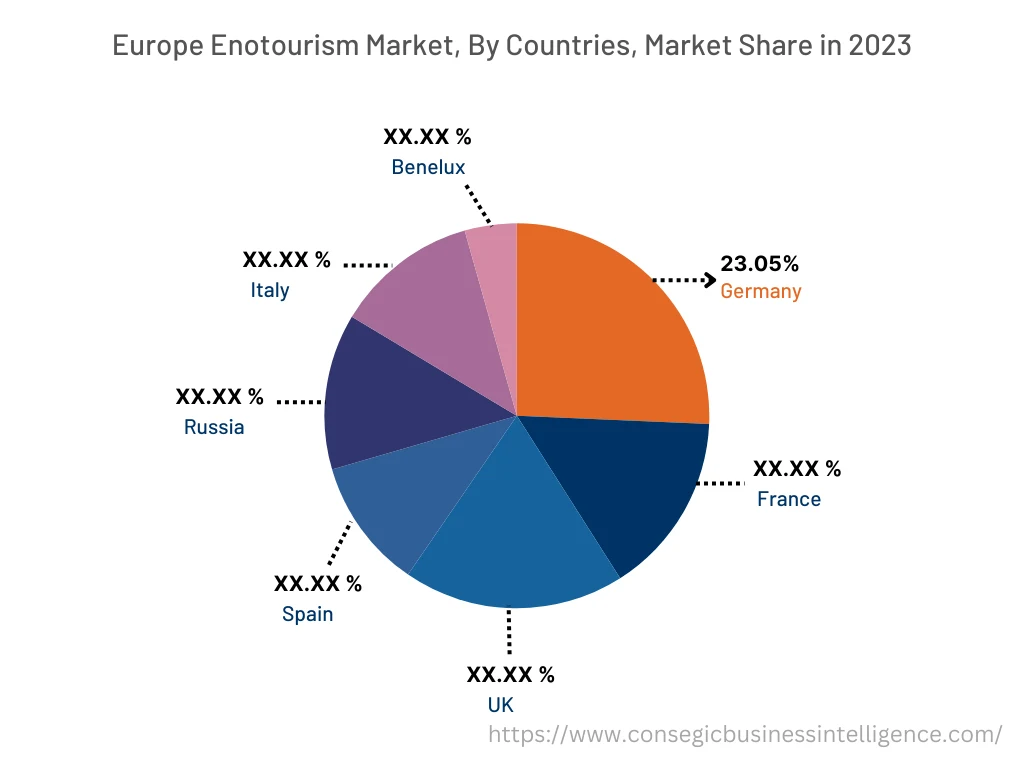
Top Key Players & Market Share Insights :
The global enotourism market is highly competitive, with several large players and numerous small and medium-sized enterprises. These companies have strong research and development capabilities and a strong presence in the market through their extensive product portfolios and distribution networks. The market is characterized by intense competition, with companies focusing on expanding their product offerings and increasing their market share through mergers, acquisitions, and partnerships. The key players in the market include-
Recent Industry Developments :
- In April 2023, Jackson Family Wines has finalised its buying of the British Columbia-based Blue Grouse Estate Winery & Vineyard.
